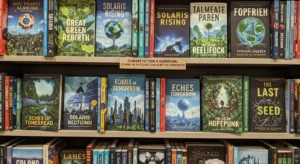The 21st century has brought climate change and social uncertainty into sharp focus, and literature has responded. While dystopian tales have long dominated speculative fiction, 2025 is witnessing the rise of two genres that combine realism with optimism: climate fiction (cli-fi) and hopepunk. These stories imagine futures shaped by ecological challenges but infused with resilience, cooperation, and hope. For many readers, they provide a way to process anxiety and envision a path forward.
What Is Climate Fiction?
 Climate fiction, often called cli-fi, refers to novels and stories that place climate change, ecological collapse, or environmental adaptation at their core. Early works often leaned dystopian—flooded cities, food scarcity, and societal breakdowns. But as the genre matured, it expanded to include nuanced perspectives: communities adapting to rising seas, technology working alongside ecosystems, and characters grappling with the ethical choices of survival and restoration.
Climate fiction, often called cli-fi, refers to novels and stories that place climate change, ecological collapse, or environmental adaptation at their core. Early works often leaned dystopian—flooded cities, food scarcity, and societal breakdowns. But as the genre matured, it expanded to include nuanced perspectives: communities adapting to rising seas, technology working alongside ecosystems, and characters grappling with the ethical choices of survival and restoration.
Some cli-fi novels are speculative, set in distant futures, while others are grounded in near-present realities. All share a central concern: how humans and nature interact in times of crisis.
What Is Hopepunk?
Hopepunk emerged as a counterbalance to grimdark narratives. Where grimdark emphasizes brutality and cynicism, hopepunk celebrates small acts of kindness, community resilience, and the idea that choosing hope in the face of despair is a form of resistance. In literary terms, hopepunk stories often feature everyday heroes who rebuild communities, restore ecosystems, or resist collapse not with violence but with compassion and collaboration.
Why These Genres Are Trending in 2025
Several factors explain the surge in popularity of climate fiction and hopepunk this year:
- Climate Reality: Wildfires, floods, and extreme weather are no longer abstract. Readers seek stories that reflect their lived reality and offer tools for processing it.
- Desire for Hope: After years of bleak dystopias, readers are craving fiction that provides optimism without ignoring the seriousness of global challenges.
- Diverse Voices: Authors from the Global South, Indigenous communities, and underrepresented groups are bringing authentic perspectives on environmental resilience, making the genres richer and more inclusive.
- Cross-Genre Appeal: Climate and hopepunk themes now appear in romance, mystery, fantasy, and YA—making them more accessible to broader audiences.
Notable Books & Authors Leading the Trend
While the canon is still forming, several works highlight the movement toward hope within climate storytelling:
- Cli-Fi with Heart: Stories that combine ecological collapse with human triumph, such as communities rebuilding after environmental disasters.
- Eco-Fantasy Hybrids: Novels where magic and ecology intertwine, blurring the line between speculative fantasy and climate awareness.
- Hopepunk Anthologies: Collections of short stories that highlight cooperation, activism, and compassion in a climate-challenged world.
How These Genres Differ from Dystopia
Traditional dystopian fiction often emphasizes collapse and despair. Climate fiction and hopepunk don’t ignore challenges, but they reframe them. Instead of asking, “What if everything ends?” they ask, “How do we adapt, resist, and rebuild?” This shift matters for readers seeking inspiration, not just warnings.
For example, where a dystopian novel might show cities abandoned after rising seas, a hopepunk story might depict coastal communities adapting with floating homes, community gardens, and new systems of governance that embrace sustainability.
Why Readers Crave These Stories
- Emotional Connection: These genres give readers language and imagination to deal with eco-anxiety.
- Agency & Empowerment: Instead of helplessness, readers encounter characters who make small but meaningful differences.
- Healing Narratives: By showing regeneration—of forests, cities, and relationships—these stories provide comfort and motivation.
How to Explore Cli-Fi & Hopepunk Without Feeling Overwhelmed
 If you’re new to these genres, here’s how to dive in thoughtfully:
If you’re new to these genres, here’s how to dive in thoughtfully:
- Start with accessible titles: Choose novels that blend cli-fi with familiar genres like romance or mystery.
- Seek out diverse authors: Look for voices from regions already experiencing climate impacts for authentic perspectives.
- Mix heavy and light reads: Balance serious cli-fi with uplifting hopepunk to avoid fatigue.
- Join reading groups: Book clubs focused on environmental literature can provide community and deeper engagement.
Challenges Facing the Genres
No movement is without criticism. Some argue that cli-fi risks becoming preachy, while others worry that hopepunk oversimplifies complex issues. There’s also the danger of “greenwashing” in publishing, where books use climate themes superficially without meaningful engagement. Readers can counter this by seeking authentic voices and critically evaluating the narratives they consume.
The Future of Cli-Fi & Hopepunk
In 2025 and beyond, these genres are likely to grow stronger. Schools and universities are incorporating cli-fi into syllabi. Publishers are scouting for stories that reflect environmental themes. And readers, increasingly conscious of their own role in climate solutions, are gravitating toward books that provide both realism and optimism.
Conclusion
Climate fiction and hopepunk are more than literary trends—they are cultural responses to an era of uncertainty. They give us stories that acknowledge the scale of our challenges while insisting on the power of resilience, empathy, and hope. For readers looking to process eco-anxiety, or simply seeking uplifting yet realistic narratives, these genres are indispensable in 2025.
Interested in more reading trends? Check out our post on Speculative Fiction You Must Read in 2025 and Books Featuring Environmental Themes for deeper exploration.
